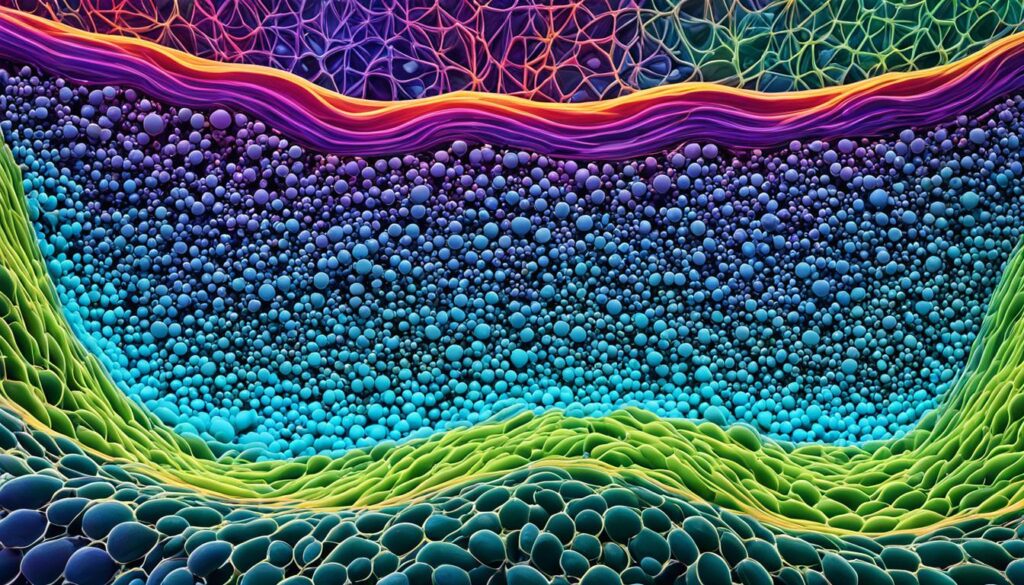India is moving toward a sustainable future, and organic (photovoltaic) PV Cell are leading the way. These solar panels, known as organic solar cells or plastic solar cells, are changing how we use clean energy. They are flexible, efficient, and eco-friendly, making them key to a greener energy future.
This article will dive into the exciting world of organic photovoltaics. We’ll look at the science behind this new technology and its many uses. From flexible solar panels to wearable devices, organic PV cells are making renewable energy more accessible and sustainable for everyone.
Key Takeaways
- Organic PV cells are a game-changer in renewable energy, offering a clean, flexible, and sustainable power solution.
- These innovative solar panels are changing the energy scene in India, providing a better alternative to traditional solar cells.
- Organic photovoltaics use organic materials to make electricity, which is flexible, cheaper to make, and better for the planet.
- Organic PV cells have many uses, from flexible solar panels to wearable tech, making renewable energy more versatile.
- As India focuses on sustainable energy, organic PV cells will be key in reaching its renewable energy goals.
Organic PV Cell: Revolutionizing Renewable Energy
The renewable energy scene is changing fast with organic photovoltaic (PV) cells. These new solar cells use organic stuff like polymers and small molecules. They could change how we get clean energy.
What are Organic Photovoltaic Cells?
Organic PV cells are a new solar tech. They use organic materials to make electricity from sunlight. They’re not like old silicon panels. These cells are light, flexible, and cheap to make. This makes them a big deal for the future of clean energy.
Advantages
Organic solar cells have some big pluses:
- Flexibility and Lightweight: These cells are bendy and light, perfect for many uses, from gadgets to building solar panels.
- Cost-Effective Manufacturing: They’re made with printing, which is cheaper than making traditional solar panels.
- Customizable Design: You can design these cells in many ways, making solar solutions that fit specific needs.
- Environmental Sustainability: They’re made from green materials, so they’re better for the planet than old silicon panels.
These points show why organic solar cells could be a big deal in renewable energy. They could change how we use clean energy in India and other places.

“Organic solar cells have the potential to transform the renewable energy landscape, offering a flexible, cost-effective, and environmentally-friendly solution for a sustainable future.”
The Science Behind Organic Photovoltaics
Organic photovoltaics (OPV) are quickly becoming a key alternative to traditional solar cells. They use carbon-based materials, making them lighter, more flexible, and cheaper. This makes them a promising choice for the future of solar technology.
Organic PV cells work thanks to organic semiconductors. These materials can catch light and turn it into electrical charges. When sunlight hits them, it excites the electrons, making them free and creating pairs called excitons.
To use this energy, we need to split and move these excitons. Organic PV cells have a special layer setup. This setup helps split the electron-hole pairs and move them to the electrodes.
Improvements in organic semiconductor materials and device design have boosted OPV efficiency. Adding printed electronics has made these solar cells flexible, light, and affordable. This makes them perfect for many uses.
As organic photovoltaics grow, researchers are finding new materials and ways to make them better. The use of printed electronics and organic solar cells could change how we use renewable energy. This could also push more people to use green technology.
“Organic photovoltaics have the potential to transform the way we think about solar energy, offering a versatile and sustainable solution for a wide range of applications.”
Applications of Organic PV Cell Technology
Organic photovoltaic (OPV) cells are changing how we use renewable energy. They’re not just for traditional solar panels anymore. Now, they’re in flexible solar panels and printed electronics, making things like wearable devices possible.
Flexible Solar Panels
Flexible solar panels are a big deal thanks to organic PV cells. They can go on many surfaces, like building walls or car roofs. This lets us use solar energy in new ways.
These panels are light and bendy, perfect for flexible solar panels. You can roll them up or fold them, making them easy to carry. This makes them great for using renewable energy in cities and the countryside, helping us move towards a sustainable energy future.
Printed Electronics and Wearable Devices
Organic PV cells are also big in printed electronics and wearable devices. They can be printed on flexible stuff, making electronics that are light, cheap, and use less energy.
These cells are changing wearable tech. They power devices that you can wear, like watches or fitness trackers. This is making a big difference in how we use electronics and is helping us use more renewable energy. It’s also opening up new ideas for the Internet of Things (IoT) and smart tech.
| Application | Advantages |
|---|---|
| Flexible Solar Panels | – Lightweight and pliable for easy integration – Adaptable to various surfaces and structures – Increased design flexibility for renewable energy |
| Printed Electronics and Wearable Devices | – Lightweight and low-cost construction – Seamless integration of power sources – Enabling innovative IoT and smart technology |
As we move towards a sustainable energy future, organic PV cell tech is key. It’s not just for solar panels anymore. It’s in wearable devices and printed electronics, too. This tech is opening up new ways to use renewable energy and power smart, green products.
Conclusion
Organic PV cells are changing the game in renewable energy. They are flexible, light, and affordable. This makes them key to India’s future with sustainable energy.
As more people use organic photovoltaics, we’ll see more clean energy. This will help make a greener and more sustainable energy future.
These organic PV cells could change how India uses renewable energy. They are easy to use and get clean power for homes, businesses, and communities. By using this green technology, India can move towards a better, energy-smarter future.
As we look for more renewable energy options, organic photovoltaics are a top choice. They are new, innovative, and fit well with India’s energy needs. These organic PV cells will help make the energy system cleaner and stronger for India.
FAQ
What are organic PV cells?
Organic PV cells, also known as organic photovoltaics or plastic solar cells, use organic materials. These include polymers and small molecules. They turn sunlight into electricity.
What are the advantages of organic solar cells?
Organic solar cells are light, flexible, and cheap to make. They can be printed easily. This makes them great for many uses, like flexible solar panels and wearable tech.
How do organic photovoltaics work?
Organic photovoltaics use organic semiconductors to catch sunlight and make electricity. Making these solar cells involves special materials and printing methods. This uses the latest in organic semiconductor and printed electronics tech.
What are the applications of organic PV cell technology?
Organic PV cell tech has many uses. It can be put on different surfaces and into various devices. This opens up new ways for sustainable power and smart tech.
How do organic solar cells compare to traditional silicon-based solar panels?
Organic PV cells are lighter, more flexible, and cheaper than traditional solar panels. But, they might not turn sunlight into electricity as well. The choice between them depends on what you need them for.

